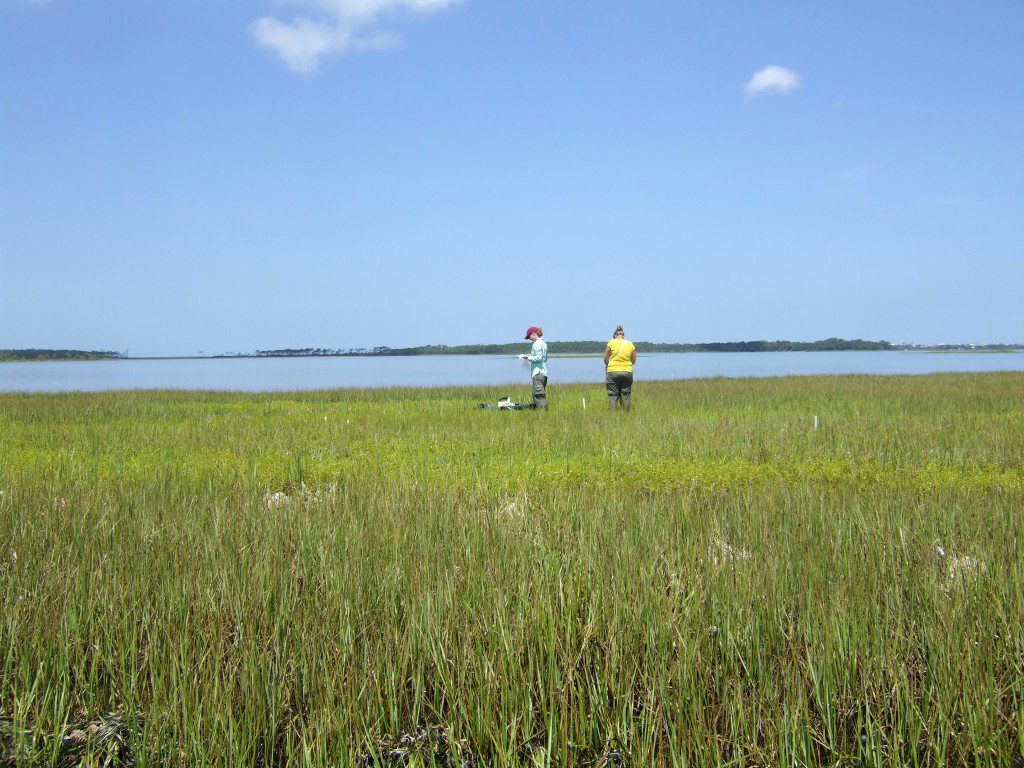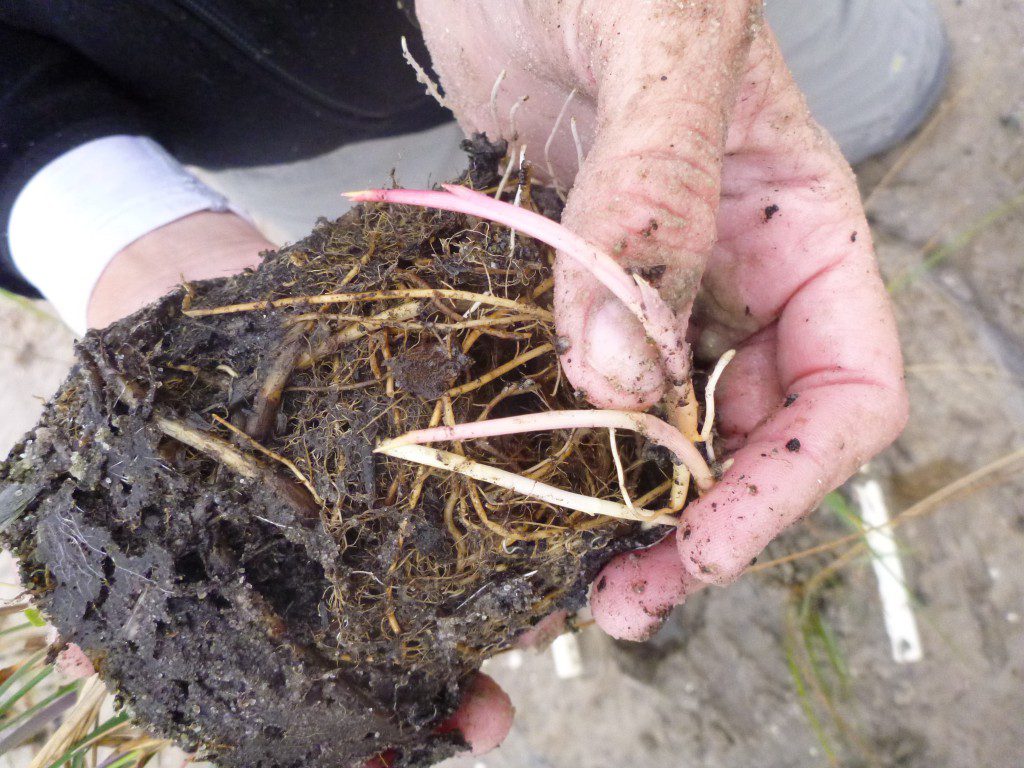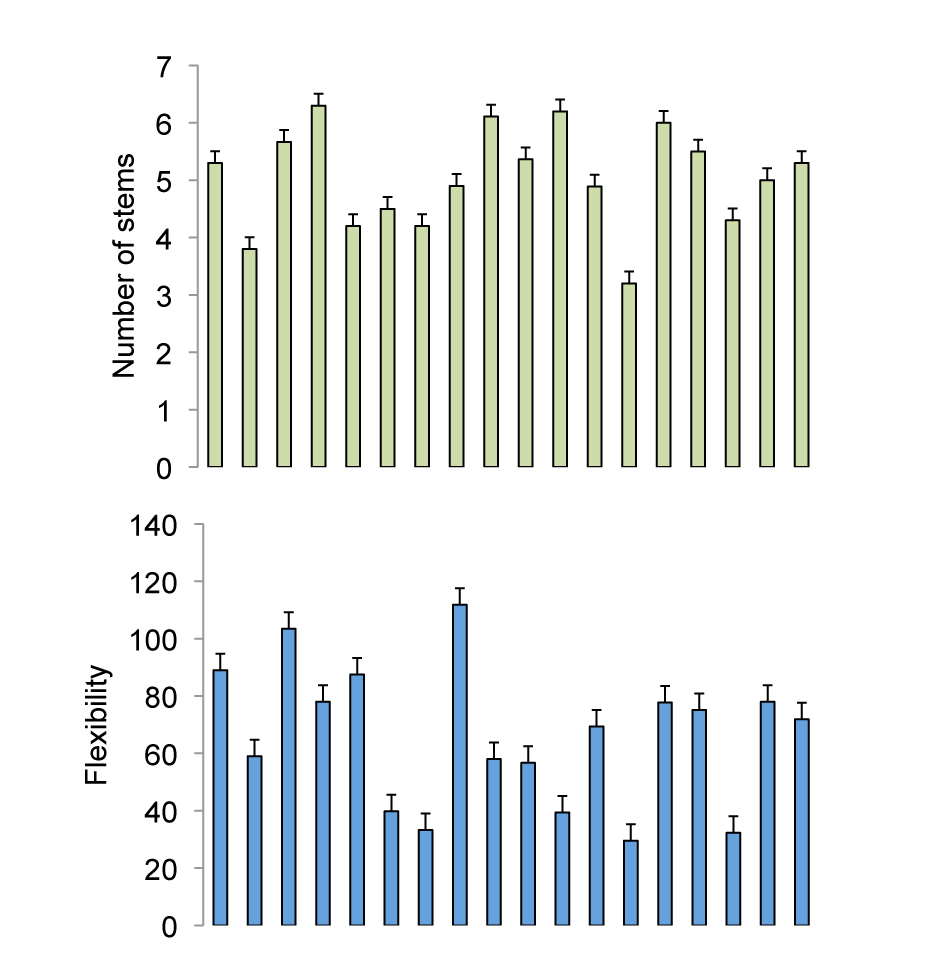As Randall mentioned in her last post, biodiversity can mean many things. In this video, she examines diversity within a species, in particular marsh cordgrass (Spartina alterniflora). Each Spartina plant has its own personality. What Randall wants to know is: are more personalities better for a salt marsh (and the sea turtles and blue crabs that use it)?
Dr. Randall Hughes FSU Coastal & Marine Lab / Northeastern University

 One of the more striking things about a salt marsh at first glance is how uniform it is. A sea of green. Or maybe a sea of green (cordgrass) in the intertidal and brown (needlerush) further back. But definitely not something that screams “diversity”. And yet, wondering about the importance of diversity in the salt marsh is what I spend a lot of my time doing.
One of the more striking things about a salt marsh at first glance is how uniform it is. A sea of green. Or maybe a sea of green (cordgrass) in the intertidal and brown (needlerush) further back. But definitely not something that screams “diversity”. And yet, wondering about the importance of diversity in the salt marsh is what I spend a lot of my time doing.
Often, when scientists talk about diversity, they are referring to different species of plants and animals (= species diversity). But there are actually lots of different kinds of diversity – functional diversity, phylogenetic diversity, genetic diversity. To illustrate what these terms mean, let’s shift to the topic I most like to think about when I’m not thinking about science – FOOD. Functional diversity is one of the broader categories, where different species are grouped by how they look or behave. So, think vegetables vs. fruits. Or, even green leafy veggies vs. root vegetables vs. berries vs. melons. Phylogenetic diversity refers to how related the species are – broccoli and cauliflower are more closely related (and thus have less phylogenetic diversity) than broccoli and zucchini – whereas species diversity refers to how many different species there are. Finally, even a single species can have a lot of diversity within it – apples are a perfect example of a fruit with large numbers of varieties to choose from. It’s this last level of diversity, genetic diversity, that I’m really interested in.

Some of a Spartina plant’s below ground root structure. Many of the plants used in Randall’s experiment have sent out rhizomes under the sediment which have sprouted new shoots. If you’re at the edge of a salt marsh and see a line of marsh cordgrass plants sticking out into the water, they’re likely connected by such a rhizome.
Unfortunately, it’s not as easy to tell different ‘varieties’ (aka, genotypes) of cordgrass apart as it is to tell a Granny Smith from a Red Delicious. Most of the plants look really similar, and it’s impossible to tell by looking from above the ground which ones are connected by roots and rhizomes below the ground. I have 2 solutions to this problem:
1. Take small pieces of cordgrass into the lab and use even smaller snippets of DNA to tell who is who. (As my dad says, think CSI with grass.)
2. Take a single cordgrass stem and grow it in a flowerpot in the greenhouse until it starts to produce lots of other stems. By splitting these up and allowing them to continue to grow (and keeping careful track of which pot is which), I can produce a supply of known cordgrass genotypes to do experiments with.
Neither of these techniques happens overnight. In fact, it took us nearly 2 full years to get enough genotypes in the greenhouse to start doing experiments with! (Proof that even someone without a green thumb – like me – can work with plants, but it takes longer than it should.)

Each bar in these graphs represents a different marsh cordgrass genotype. You can see how each plant differs in “personality” from its number of stems and flexibility.
The cool thing about spending that much time with these plants is that you start to recognize that they have their own flavors or personalities. Some grow a few really tall stems vs. others with lots of average size stems; some flower in July vs. others that flower in October; some have really flexible stems vs. others that are more rigid (which probably matters if you’re a snail climbing up the stem).
It’s these different personalities that may allow a mixture of multiple genotypes to do better over time than a genotype growing by itself. For one, if some genotypes are better at surviving some sort of disturbance, then having a mixture of genotypes increases the chances that one of those “good” genotypes is included in the mix. Or, if genotypes are all a little bit different, they may be complementary to one another, allowing the mixture to do better than any one of them growing alone. (This “complementarity” can also be referred to as facilitation, and it’s an idea we’ll return to in coming weeks.)
We have several experiments that are wrapping up now that test this very idea – do diverse marsh patches perform better than less diverse patches? If so, why does that happen? Early indications are that the answer is like a lot of things in nature – it depends. Sometimes the diverse patches do better, and sometimes they don’t. So now the trick is to figure out how to predict when diversity will matter, and use that information to help conserve existing salt marshes and restore marshes that have been damaged in the past (which can help provide a steady supply of blue crabs for both sea turtles and us!).
Music in the piece by airtone. Thanks to Mineral Springs Seafood for letting us tag along as they emptied their crab traps. And thanks to Gulf Specimen Marine Lab for the underwater footage of Allie the sea turtle (good luck out there, Allie!).
This material is based upon work supported by the National Science Foundation under Grant Number 1161194. Any opinions, findings, and conclusions or recommendations expressed in this material are those of the author(s) and do not necessarily reflect the views of the National Science Foundation.
